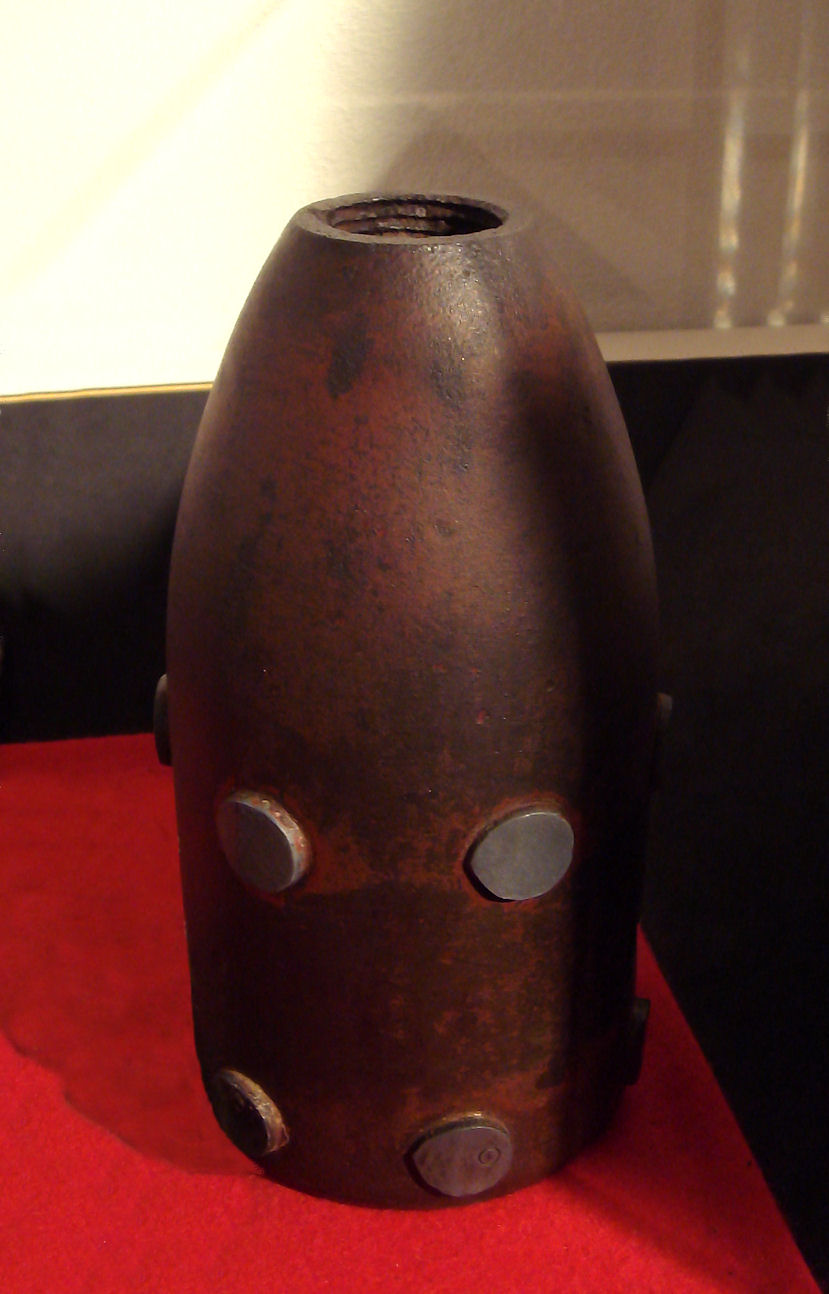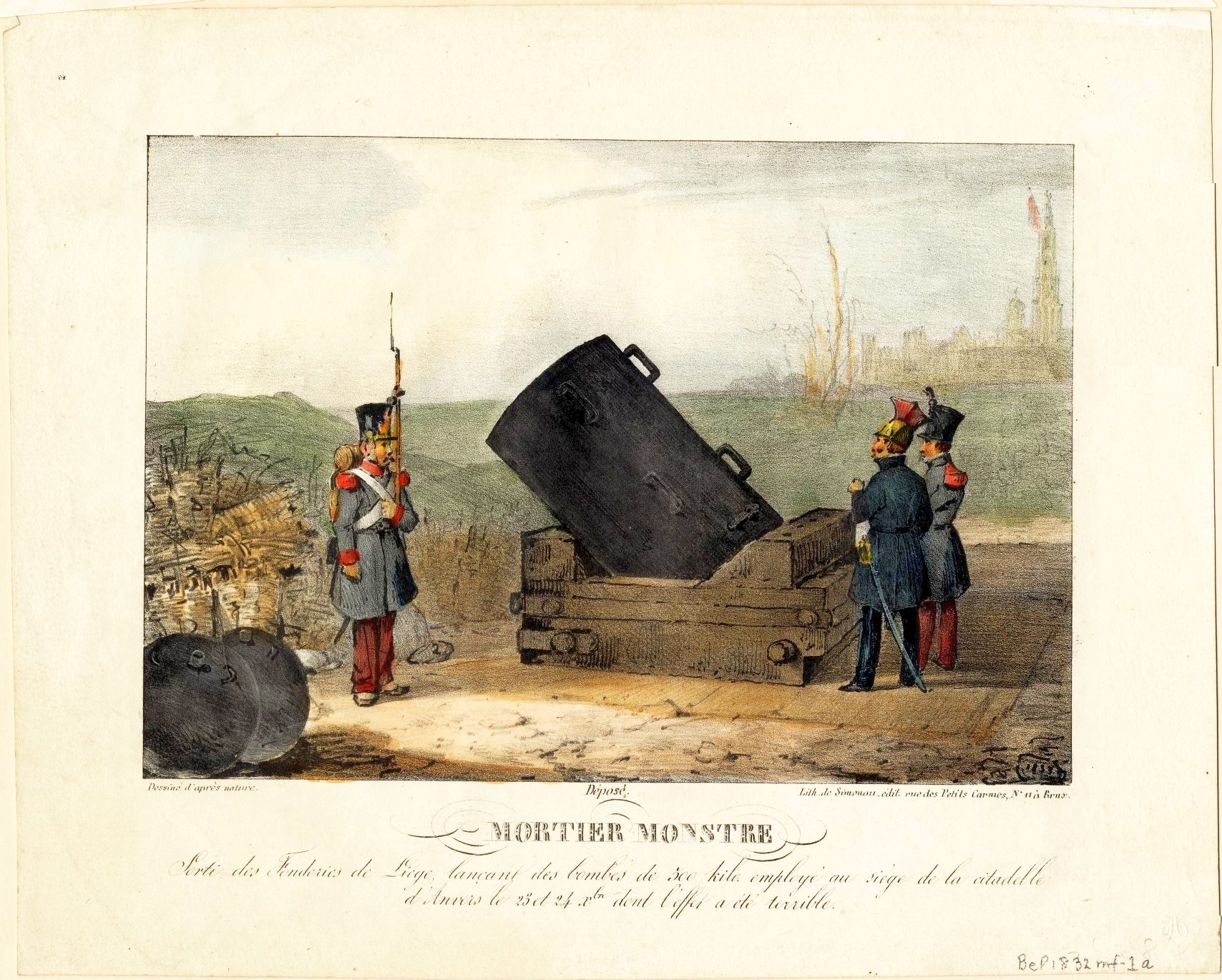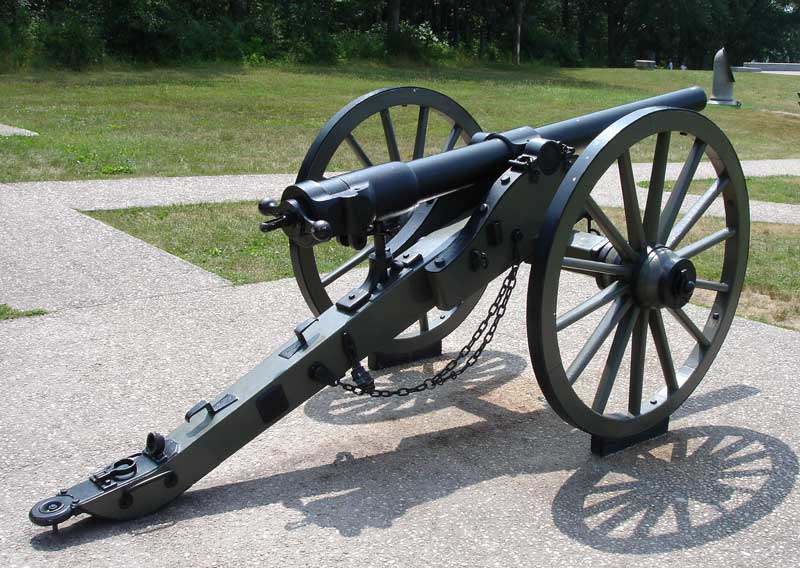|
Canon-obusier
The Canon-obusier (literally "Shell-gun cannon", "gun-howitzer") was a type of cannon developed by France in the 1850s. The canon-obusier was a smoothbore cannon using either explosive shells, solid shot, or canister, and was therefore a vast improvement over previous cannon firing only solid and canister shot, such as the Gribeauval system. The very first canon-obusiers were naval shell guns, invented in 1823 by Henri-Joseph Paixhans and introduced in the French Navy in 1842. This invention was related to the origin of the development of the Dahlgren shell gun in the United States in 1849. The French Army introduced the canon-obusier de 12 in 1853. The US version of this type of canon-obusier, commonly called the "12-pounder Napoleon Model 1857", was one of the most-used cannon in the American Civil War. Over 1,100 of these "Napoleons" were manufactured by the Union, and 600 by the Confederacy. The canon-obusier de 12 followed rifled cannon of the Treuille de Beaulieu sy ... [...More Info...] [...Related Items...] OR: [Wikipedia] [Google] [Baidu] |
Canon-obusier De 12
The Canon obusier de 12 (officially the "Canon obusier de campagne de 12 livres, modèle 1853"), also known as the "Canon de l’Empereur" ("emperor's cannon"), was a type of canon-obusier (literally "shell-gun cannon", "gun-howitzer") developed by France in 1853. Its performance and versatility (it was able to fire either ball, shell, canister or grapeshot) allowed it to replace all the previous field guns, especially the Canon de 8 and the Canon de 12 as well as the two howitzers of the Valée system. The cannon was known in the United States as the 12-pounder Napoleon after French President and Emperor Napoleon III. Characteristics The ''"canon obusier"'' was a smoothbore cannon firing either shells, balls, or canister. This was an improvement over previous cannon firing only balls, such as those of the Gribeauval system. The ''"canon obusier de 12 livres"'' is commonly described as a "12-pounder" in English, although the nominal rating was based on a slightly different measu ... [...More Info...] [...Related Items...] OR: [Wikipedia] [Google] [Baidu] |
Antoine Treuille De Beaulieu
Count Antoine Hector Thésée Treuille de Beaulieu (7 May 1809 – 24 July 1885) was a French General of the 19th century, who developed the concept of rifled guns in the French Army. He studied the subject of rifling between 1840, particularly in the famous Manufacture d'armes de Châtellerault, and 1852. Following a request by Napoleon III in 1854 to develop such a weapon, the de Beaulieu system was adopted by the French Army. It consisted in cutting six grooves inside the bore of a muzzle-loading cannon, and to use shells equipped with six lugs which would engage the grooves.''A Dictionary of Military History and the Art of War'' by André Corvisier, p.4/ref> This development was paralleled by that of the Armstrong gun in Great Britain (adopted in 1858 by the British Army). About the same time he developed a pinfire falling-block breech-loading carbine (''mousqueton'') for the Cent-gardes Squadron which was a bit ahead of its time in using a metallic cartridge and is very unusu ... [...More Info...] [...Related Items...] OR: [Wikipedia] [Google] [Baidu] |
Dahlgren Gun
Dahlgren guns were muzzle-loading naval artillery designed by Rear Admiral John A. Dahlgren USN (November 13, 1809 – July 12, 1870), mostly used in the period of the American Civil War. Dahlgren's design philosophy evolved from an accidental explosion in 1849 of a gun being tested for accuracy, killing a gunner. He believed a safer, more powerful naval cannon could be designed using more scientific design criteria. Dahlgren guns were designed with a smooth curved shape, equalizing strain and concentrating more weight of metal in the gun breech where the greatest pressure of expanding propellant gases needed to be met to keep the gun from bursting. Because of their rounded contours, Dahlgren guns were nicknamed "soda bottles", a shape which became their most identifiable characteristic. Dahlgren boat howitzers During the Mexican–American War the U.S. found itself lacking in light guns that could be fired from ships’ boats and landed to be used as light artillery in suppor ... [...More Info...] [...Related Items...] OR: [Wikipedia] [Google] [Baidu] |
Henri-Joseph Paixhans
Henri-Joseph Paixhans (; January 22, 1783, Metz – August 22, 1854, Jouy-aux-Arches) was a French artillery officer of the beginning of the 19th century. Henri-Joseph Paixhans graduated from the École Polytechnique. He fought in the Napoleonic Wars, was the representative ( Député) for the Moselle department between 1830 and 1848, and became "General de Division" in 1848. In 1823, he invented the first shell guns, which came to be called Paixhans guns (or "canon-obusiers" in the French Navy). Paixhans guns became the first naval guns to combine explosive shells and a flat trajectory, thereby triggering the demise of wooden ships, and the iron hull revolution in shipbuilding. Paixhans also invented a "Mortier monstre" ("Monster Mortar"), using 500 kg bombs, which was used to terrible effect in the Siege of Antwerp in 1832. He was also a naval theorist claiming that a few aggressively armed small units could destroy the largest naval units of the time, making him a prec ... [...More Info...] [...Related Items...] OR: [Wikipedia] [Google] [Baidu] |
Twelve-pound Cannon
The twelve-pound cannon is a cannon that fires twelve-pound projectiles from its barrel, as well as grapeshot, chain shot, shrapnel, and later shells and canister shot. It was first used during the Tudor period and was commonly used during the Napoleonic Wars, 1799–1815. At this time 12-pounders were the largest caliber of long-barreled field pieces, and were used both at long range against fortifications and troop concentrations using round shot and against attacking infantry and cavalry using canister shot. As such the 12-pounder was a favorite weapon of the Grande Armée. Later, redesigned 12-pounders were named after Napoleon III and found heavy use during the American Civil War. Twelve-pounders were also carried on naval vessels of various sizes. Unlike their land-based cousins, such weapons were considered light by naval standards. They formed the main armament of smaller frigates, and were used on the upper decks of larger vessels, where their relatively lighter weight ... [...More Info...] [...Related Items...] OR: [Wikipedia] [Google] [Baidu] |
Howitzer
A howitzer () is a long- ranged weapon, falling between a cannon (also known as an artillery gun in the United States), which fires shells at flat trajectories, and a mortar, which fires at high angles of ascent and descent. Howitzers, like other artillery equipment, are usually organized in a group called a battery. Howitzers, together with long-barreled guns, mortars, and rocket artillery, are the four basic types of modern artillery. Mortars fire at angles of elevation greater than 45°, and are useful for mountain warfare because the projectile could go over obstacles. Cannons fire at low angles of elevation (<45°), and the projectile lands much faster at its target than it would in the case of a mortar. But the cannon is not useful if there is an obstacle like a hill/wall in front of its target. Etymology The English word ''howitzer'' comes from the Czech word , from , 'crowd', and is in turn a borrowing from the Middle High German word or (mode ...[...More Info...] [...Related Items...] OR: [Wikipedia] [Google] [Baidu] |
World War I
World War I (28 July 1914 11 November 1918), often abbreviated as WWI, was one of the deadliest global conflicts in history. Belligerents included much of Europe, the Russian Empire, the United States, and the Ottoman Empire, with fighting occurring throughout Europe, the Middle East, Africa, the Pacific, and parts of Asia. An estimated 9 million soldiers were killed in combat, plus another 23 million wounded, while 5 million civilians died as a result of military action, hunger, and disease. Millions more died in genocides within the Ottoman Empire and in the 1918 influenza pandemic, which was exacerbated by the movement of combatants during the war. Prior to 1914, the European great powers were divided between the Triple Entente (comprising France, Russia, and Britain) and the Triple Alliance (containing Germany, Austria-Hungary, and Italy). Tensions in the Balkans came to a head on 28 June 1914, following the assassination of Archduke Franz Ferdin ... [...More Info...] [...Related Items...] OR: [Wikipedia] [Google] [Baidu] |
Confederate States Of America
The Confederate States of America (CSA), commonly referred to as the Confederate States or the Confederacy was an unrecognized breakaway republic in the Southern United States that existed from February 8, 1861, to May 9, 1865. The Confederacy comprised U.S. states that declared secession and warred against the United States during the American Civil War: South Carolina, Mississippi, Florida, Alabama, Georgia, Louisiana, Texas, Virginia, Arkansas, Tennessee, and North Carolina. Kentucky and Missouri also declared secession and had full representation in the Confederate Congress, though their territory was largely controlled by Union forces. The Confederacy was formed on February 8, 1861, by seven slave states: South Carolina, Mississippi, Florida, Alabama, Georgia, Louisiana, and Texas. All seven were in the Deep South region of the United States, whose economy was heavily dependent upon agriculture—particularly cotton—and a plantation system that relied upon enslaved ... [...More Info...] [...Related Items...] OR: [Wikipedia] [Google] [Baidu] |
Union (American Civil War)
During the American Civil War, the Union, also known as the North, referred to the United States led by President Abraham Lincoln. It was opposed by the secessionist Confederate States of America (CSA), informally called "the Confederacy" or "the South". The Union is named after its declared goal of preserving the United States as a constitutional union. "Union" is used in the U.S. Constitution to refer to the founding formation of the people, and to the states in union. In the context of the Civil War, it has also often been used as a synonym for "the northern states loyal to the United States government;" in this meaning, the Union consisted of 20 free states and five border states. The Union Army was a new formation comprising mostly state units, together with units from the regular U.S. Army. The border states were essential as a supply base for the Union invasion of the Confederacy, and Lincoln realized he could not win the war without control of them, especially Maryla ... [...More Info...] [...Related Items...] OR: [Wikipedia] [Google] [Baidu] |
American Civil War
The American Civil War (April 12, 1861 – May 26, 1865; also known by other names) was a civil war in the United States. It was fought between the Union ("the North") and the Confederacy ("the South"), the latter formed by states that had seceded. The central cause of the war was the dispute over whether slavery would be permitted to expand into the western territories, leading to more slave states, or be prevented from doing so, which was widely believed would place slavery on a course of ultimate extinction. Decades of political controversy over slavery were brought to a head by the victory in the 1860 U.S. presidential election of Abraham Lincoln, who opposed slavery's expansion into the west. An initial seven southern slave states responded to Lincoln's victory by seceding from the United States and, in 1861, forming the Confederacy. The Confederacy seized U.S. forts and other federal assets within their borders. Led by Confederate President Jefferson Davis, ... [...More Info...] [...Related Items...] OR: [Wikipedia] [Google] [Baidu] |
French Army
The French Army, officially known as the Land Army (french: Armée de Terre, ), is the land-based and largest component of the French Armed Forces. It is responsible to the Government of France, along with the other components of the Armed Forces. The current Chief of Staff of the French Army (CEMAT) is General , a direct subordinate of the Chief of the Defence Staff (CEMA). General Schill is also responsible to the Ministry of the Armed Forces for organization, preparation, use of forces, as well as planning and programming, equipment and Army future acquisitions. For active service, Army units are placed under the authority of the Chief of the Defence Staff (CEMA), who is responsible to the President of France for planning for, and use of forces. All French soldiers are considered professionals, following the suspension of French military conscription, voted in parliament in 1997 and made effective in 2001. , the French Army employed 118,600 personnel (including the Fo ... [...More Info...] [...Related Items...] OR: [Wikipedia] [Google] [Baidu] |





